※ The exhibition period of Artists in Their Times: Korean Modern and Contemporary Art
(Gallery 3, 4) 4.Aug.2020. ~ 18.Sep.2022.
(Gallery 5, 6) 21.Jul.2020. ~ 31.Jul.2022.
Artists in Their Times: Korean Modern and Contemporary Art
This large–scale permanent exhibition featuring works in the museum collection examines major currents of Korean modern and contemporary art. Approaching the course of Korean art history not from inside the art world itself, but from a periodic and social perspective, the exhibition intends to overview the atmosphere and the evolving situations surrounding the featured works by providing archival materials key to understanding the background from which the works emerged. This 15–section exhibition delineating some 120 years of Korean modern and contemporary art history was organized in cooperation with researchers specializing in each historical period.
Art in the early 20th century departed from the question of how to represent reality, diverging into different styles of expression that embody subjectivity and character. As the weight of the question shifted toward "what is real," there emerged works with existential tendencies and various experiments with artistic expression. The later art scene formed a rivaling structure between abstract art with monochrome leanings and Minjung art styles that penetrated the times—a structure that was soon dismantled to give rise to pluralistic works that sought decentralization. Meanwhile, the traditional Korean art scene sought to define the identity of "hangukhwa" (Korean painting) through self–transformation. Through Japanese occupation, liberation, the Korean War, national division, the April 19 Revolution, the Yushin regime, and the 1988 Summer Olympics in Seoul, leading into the era of globalization, Korean artists have demonstrated an unyielding artistic consciousness, striving to sublimate the ordeals brought upon by history into works representative of a zeitgeist.
Galleries 5 and 6 on the third floor marshal artworks from the 1900s to 1970s. Continuing on the second floor, Galleries 3 and 4 and the corridor present works from the late 1970s to 2000s. Walking through different time periods and witnessing how art has evolved with the changing circumstances of the country, the audience will be able to grasp the organic relationship between art and society, and the periodic development of different artistic media.
The MMCA has presented an array of exhibitions highlighting Korean art history and has acquired and managed an extensive collection and archive with its focus on establishing a comprehensive history of Korean art. This exhibition will be an opportunity for the museum to casually approach the public and open their eyes to Korean art and history.
Korean Art in the First Half of the 20th Century(1-3)
Over the course of the 20th century from the 1900s to the 1950s, Korean history underwent a period of profound turbulence. While the century was rung in with the conflict between the Wijeong Cheoksa ("uphold orthodoxy and reject heterodoxy") proponents that sought to keep the nation closed and uphold traditions and the Gaehwa ("enlightenment") proponents that played a leading role in actively adopting new culture from China and Japan, that conflict would end with the humiliation of Korea being stripped of its sovereignty with its 1910 annexation by Japan.
Under the stern military rule of imperial Japan, most cultural activities came to a stop. In the wake of the March 1 Independence Movement came an era of cultural rule, with the first national art exhibition taking place under the control of the Joseon Government–General. During the Japanese occupation, the period when Korean artists enjoyed "relatively" more freedom to receive art education and pursue artistic activities was a brief window of time between the 1920s and 1930s.
But after the notorious militarism of the late Japanese empire came Korea's liberation in 1945, and the five years until the outbreak of the Korean War represented a turbulent period of intense conflict between left–wing and right–wing politics. The eruption of the Korean War was a major incident in world history, ushering in the Cold War era.
Even amid this chaos, many people in Korea opted to pursue careers in art. Perhaps it is inappropriate to say, "they could not give up art despite the hardships." Rather, itis because of art that they seem to have been able to summon the courage and resistance to overcome their hardships. The first gallery in this exhibition features their stories and some of the invaluable works they left behind.
1. Transformation of Traditional Art and the Introduction of Oil Painting Early 1900s
During the Joseon era, there had been many professional painters among the middle class, who had been affiliated with palaces or produced work to meet the demands of the aristocracy. This traditional artist lineage was carried on by Chae Yongsin, a royal painter who produced a portrait of Emperor Gojong. At the same time, Chae was also a "freelancer" who set up his own studio to meet the new demand for art. After the Eulsa Treaty of 1905, he retired to the countryside, where he built a reputation by producing portraits of Wijeong Cheoksa group leaders (mainly neo–Confucianist scholars) using intricate, detailed techniques reminiscent of photography. The production methods and distribution structure of traditional art was undergoing a gradual change. Meanwhile, actively "enlightened" painters emerged with figures such as An Choongsik and Kim Kyujin, who sought to marry old values to new techniques at the intersection between traditional and modernity.
Ko Huidong, a member of the upper–middle class and student of French, was the first Korean to travel to Tokyo to learn oil painting. He attended the Tokyo Fine Arts School, which assigned him the creation of a "self–portrait" as a graduation project. The self– portrait, with its examination and expression of the artist's own identity, was a foreign genre from the standpoint of traditional art concepts. A sea change arose in perceptions of the stature and role of the artist. The first generation of oil painters, most of whom studied abroad in Tokyo, would research and import other new genres of Western art besides self–portraits, including nudes and landscapes.
2. Government Exhibition Art and the Emergence of New Forms of Expression 1920–1940s
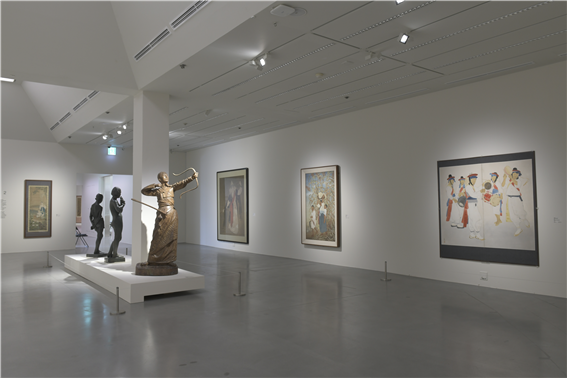
After the end of World War I and the March 1 Independence Movement, the art worlds of the 1920s underwent a change in topography. Transitioning into a system of "cultural rule," the Japanese government established the Joseon Art Exhibition in 1922, holding yearly art exhibitions that received large–scale promotion in the press. Korean artists disparaged the events as "the Governor–General's exhibitions," staging their own Korean–led exhibition centering on the Society of Calligraphy and Painting. But the Joseon Art Exhibition remained the only gateway available for artists, serving as a yardstick for many artists to gauge their own capabilities as they continued on with their artistic careers. Ambitiously scaled "exhibition works" were produced to be shown at the events, and so–called "stars of Joseon Art Exhibition" emerged during this time.
This period also saw the appearance of artworks revealing new sensibilities and the unique styles of artists. In the case of Western–style art, new artworks incorporated elements not only of impressionism, which corresponded to the "academism" of the time, but also of fauvism, surrealism, and abstraction. The idea of painting being a form of free expression to reveal the artist's subjectivity and individuality, rather than simply a technique for representing objects as they appeared, would allow for the development of a wide variety of artistic forms.
3. Liberation and Postwar Art 1940–1950s
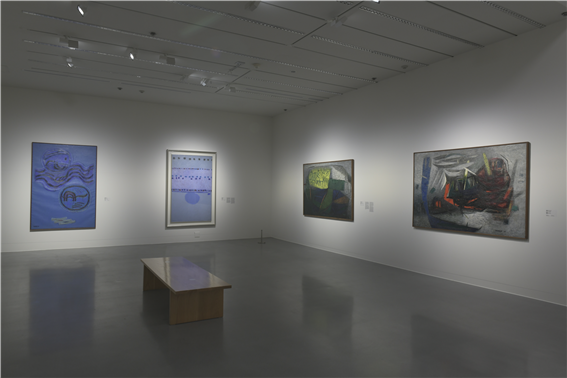
South Korea was liberated from Japanese rule in August 1945. But the thrill of liberation lasted for only a short time before the new ideological battle and societal conflicts reached a fever pitch. As if to reflect the societal situation, the number of artworks produced over the roughly five–year period between 1945 and the outbreak of the Korean War in 1950 was exceedingly small. The works from this time reflect both hope for the new country and despair over its reality.
Erupting in 1950, the Korean War would serve to entrench the division of the Korean Peninsula. While socialist realism became the chief approach in North Korea, the effect in South Korea was to encourage more active adoption of Western art from the US and Europe. In the wake of historical artworks recording the grim images and reality of the postwar era came the abstract approach. Abstract artists such as Kim Whanki and Yoo Youngkuk also emerged, drawing on Korean lyricism and adopting Korea's landscape as their subject matter.
4. Prelude to Contemporary Art: Informel 1960s
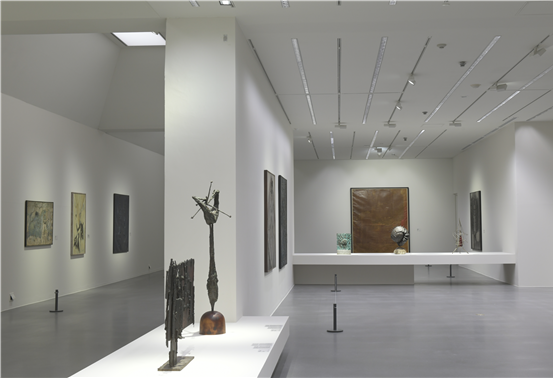
Amid the political and social turbulence of the post– Korean War period from the late 1950s into the 1960s, the Korean art world was also undergoing change. Various art groups were created in opposition to state–led art exhibitions (specifically the National Art Exhibition , also known as "Gukjeon" for short), and activities in contemporary art expanded through ongoing invitational exhibitions of an opposition character. An example of this was a street exhibition held the same year as the April 19 Revolution (1960) in which large abstract works of art were hung by artist groups on the western and northern walls of Deoksugung Palace, the venue where the Gukjeon was taking place. It represented a kind of protest, appealing to the public by creating an event to raise issues with the conservative art establishment.
During this period, artists deepened their artistic work into a zeitgeist of sorts. They created works leaning toward informel , a post–World War II European art form representing a form of existential introspection as a product of contemporary tensions and conflicts. The paintings boasted powerful brushstrokes and material qualities as an expression of the artist's interior world; the sculptures showed traces of human actions with new materials—including iron, a substance associated with modern civilization—and welding marks. In Eastern painting as well, an avant–garde consciousness spread within the art world as artists created abstract works emphasizing brushwork and ink effects as a way of establishing contemporaneity.
Meanwhile, artists began participating in biennials and other international exhibitions, which served as an opportunity to broaden their awareness of international art and examine Korea's situation and possibilities. In these ways, the art of this era assumed an oppositional aspect vis–à–vis the establishment, pursuing change in accordance with the international art environment as a formative movement closely tied to the zeitgeist.
5. Experiments with Modes of Expression 1960–1970s
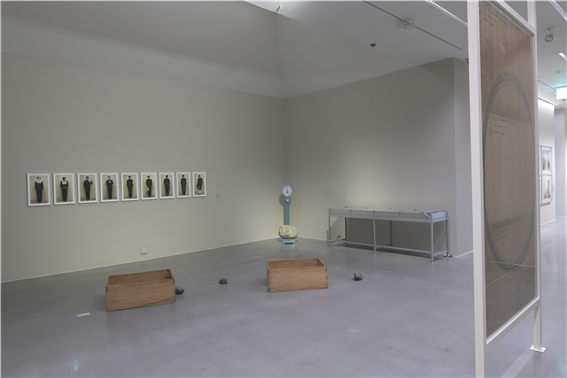
From the introduction of ordinary items as art objects to explorations of the new methodologies of installation and action and the new media of photography and video, the trajectory of Korean art in the 1960s and 1970s can be traced to a great variety of experiments with forms of artistic expression.
The world was going through a turbulent time, with the fervor of hippie and resistance culture juxtaposed against the bleakness of a cold and stark international situation, as exemplified by the Vietnam War. Under its authoritarian political regime, Korea was racing breathlessly on a path of state–led industrialization, with its five–year economic development plans and Saemaul (New Village) Movement. Also coursing this dynamic moment was an endless outpouring of desire for democracy and freedom, as seen in the April 19 Revolution of 1960.
Even at a time when society as a whole was oppressed by an atmosphere prioritizing security and "modernization of the homeland," lone battles for the freedom of critical individuals were constantly being revived. Attempts to break through the authoritarian, hidebound social and cultural framework through different experiments with various modes of expression continued against a backdrop of youth culture exemplified by blue jeans and guitars. To be sure, these experiments could only do so much in achieving solid long–term continuity amid the various prevailing social conditions. But the more basic questions that they raised about art concepts, and the attempts to link together different elements spanning different fields, can be seen as having contributed significantly to achieving healthy "biodiversity" in the Korean contemporary art ecosystem.
These attempts represented pioneering efforts and examples before the real emergence of later generations' artworks based on different linkages. In this sense, they can be seen as having provided the soil for contemporary art to blossom in various ways, and their reassessment and rediscovery continues to this day.
6. Monochrome Artwork of the 1970s
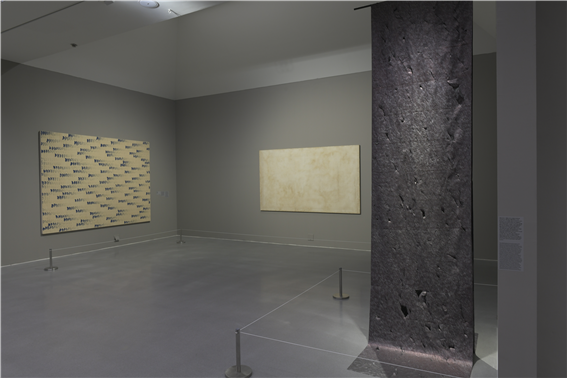
Under the Yushin system of the 1970s, various cultural policies were introduced with an emphasis on reviving and rebuilding national traditions. Amid this climate, Korean art came to reflect a Korean aesthetic consciousness that emphasized harmony with nature and spiritual qualities. This could be seen as originating in a search for the identity of Korean art, where the "national" was equated with the "global."
Invitational exhibitions began taking place every year, beginning with the Indépendants exhibition and various solo exhibitions in the early 1970s and continuing on with the École de Seoul and Seoul Contemporary Art Festival. By the late 1970s, works of a monochrome character were experiencing a major rise. Artwork with monochrome associations emerged as a kind of bloc within Korean art, with characteristics such as repeated actions and emphasis on the physical aspects of materials. A fundamental change occurred in perceptions of painting: the canvas was seen less as a setting for representing things than as one for revealing existence, while representation as such was kept to a minimum.
The interest that Japan was showing toward Korean contemporary art became an important factor in strengthening the identity of Korean art. In 1975, the exhibition Korea: Five Artists, Five Hinsek 'White' was held at Tokyo Gallery, and exhibitions of Korean art would take place throughout Japan over the next decade or so, including solo and group exhibitions as well as exhibitions at major art museums. "White monochrome" was mentioned for the first time in Japan, and as it became tied to the inherent sentiments of Korea, it broadened into a discussion on the identity of Korean art. This tendency holds an important place in contemporary Korean art history, and its relationship with Western and Japanese art has been the subject of ongoing research through Korean and overseas discourses.
7. A New Figurative Painting Emerges: Korean Hyperrealism Late 1970–1980s
One of the major developments in Korean contemporary art between the late 1970s and 1980s was the rise of realist and figurative art, which emphasized figures and expressions and were rooted in the social reality. The new figurative painting emerged first in the late 1970s with hyperrealism, which was characterized by elaborate depictions achieved through intense craftsperson–like efforts. Korean hyperrealism was an expression of skepticism and rejection toward Gukjeon – centered academist representational painting and an attempt to break away from Korea's fixed trend of monochrome painting at the time; it sought a restoration of figures and recovery of story/narrative.
The young artists leading the hyperrealism movement appeared in small group exhibitions such as Realism of the Postwar Generation, Figure 78, Fact and Reality, and Visual Message, with works that incorporated themes such as aspects of modern reality, urban landscapes, and natural and artificial objects. Hyperrealism rose to the surface of the art world, sweeping awards at the minjeon(non–government juried) exhibitions that emerged during the late 1970s, and the hyperrealist works of such artists as Kim Changyoung, Ju Taeseok, and Ji Seokcheol, drew notice as a new trend at the inaugural The Korean Young Artists Biennial exhibition held in 1981 by the National Museum of Modern and Contemporary Art, Korea.
Korean hyperrealism was characteristic by its emphasis of objects to depict natural and artificial objects in ultra–realistic ways, from Ju Taeseok's railways and Kim Kangyong's cement blocks to Kim Changyoung's sand fields, Ji Seokcheol's sofa cushions, Lee Sukju's walls, and Ko Younghoon's stones. At the same time, artists presented endlessly sprawling natural landscapes on the canvas or repeatedly overlaid their subjects to produce frontal images stripped of a sense of spatial depth. This dual structure, with their juxtaposition of figures and abstraction, illusion and flatness, was a unique characteristic of Korean hyperrealism.
8. Korean Painting since the 1980s 1980s and Onward
The biggest change that arose in the 1980s for traditional artists using the three materials known as jipilmuk (paper, brush, and ink) was the first real use of the term "hangukhwa" (meaning "Korean painting"). This could be seen both as a bid for recognition as a genre of contemporary art—with the pursuit of new formative qualities and adoption of new techniques—as well as the starting point for an investigation into identity.
The adoption of abstract qualities by traditional painters dates back to the 1960s and the emergence of the art group known as the Mungnimhoe (Ink Forest Group). Its members sought to achieve a transformation in Eastern painting by incorporating Western formative aspects. The early 1980s brought an ink–and–wash painting boom with the emergence of an ink–and– wash movement. Insisting that abstraction was by no means exclusive to the West, its members broadened the scope of ink–and–wash by underscoring the material aspects of ink even as they emphasized spiritual aspects in the "literary artist" style (muninhwa). They also attempted modern reinterpretations of ink painting with the production of landscape images recreating scenes from nature.
This ink–and–wash dominance would give way to the adoption of color in the wake of a 1984 exhibition by Park Saengkwang. The new direction presented for chaesaekhwa (polychrome) painting became the question of what constituted "Korean coloring" as opposed to the "Japanese style." Park created works that rendered folk subject matter in powerful colors; by the late 1980s, he was focusing on folk art forms of expression, incorporating everyday emotions with frank and humorous variations on polychrome and ink–and–wash painting. He also experimented with different materials, expanding the boundaries of the jipilmuk approach to produce artwork that transcended two–dimensionality.
Amid the ever greater focus on everyday life in hangukhwa painting, ink–and–wash was not simply used as an expressive medium—it represented a departure from the dualistic values of "spiritual vs. material" or "ink vs. color." Alongside their efforts to carry on tradition, hangukhwa painters sought to assess the current state of affairs and develop a new artistic language.
9. Minjung Art 1980s
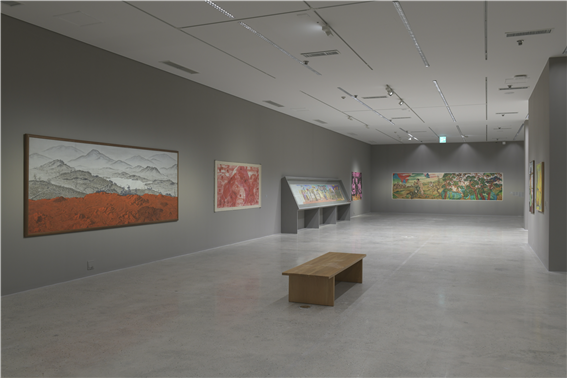
Korea's first large–scale endogenous art movement, Minjung art was distinct from previous Korean art in its attention to real–world concerns and focus on content and narrative. The 1979 establishment of such representative Minjung art movement groups as Reality and Utterance and the Gwangju Free Artists Association would have a major influence on Korean painting through the 1980s and early 1990s, forming a central axis in the Minjung art movement. Smaller groups such as Imsulnyeon (The Year of Imsul, 1982) and Dureong Group (1983) were also established and
became prolifically active.
The historical situation in Korea played a large part in Minjung art becoming representative of Korean art in the 1980s. Resistance to the oppressive military regime (as symbolized by the Gwangju Democratization Movement) and re–examinations of the US as a traditional ally were rippling through Korean society as a whole at the time, leading to more active debates over democracy and nationalism. Minjung art was born out a sense of crisis and the feeling that art could no longer ignore reality. In addition to this, the pursuit of figurative art (hyperrealism) that had emerged as an alternative to the monochrome tendencies that dominated Korea's art scene of the 1970s played a mediating role of sorts in the emergence of Minjung art as its precise depictions of objects revealed an interest in reality.
Minjung art took on the aspect of art "shared with the masses," as exemplified in the large wall hangings shown in the settings of labor and social movements and the woodcuts used for illustrations in publications. It assumed different forms, drawing on imagery from comics, advertisements, and other forms of popular culture or creating images through photography and collage techniques.
Minjung art's character as a movement weakened in the early 1990s, entering a general decline amid the dissolution of the Cold War climate and arrival of Kim Young–sam's civilian administration. After the 1994 The 15 Years of Korean Minjoong Arts: 1980–1994 exhibition at MMCA, it is seen as having been subsumed into institutional art.
10. Activities of Diverse Small Groups in the 1980s
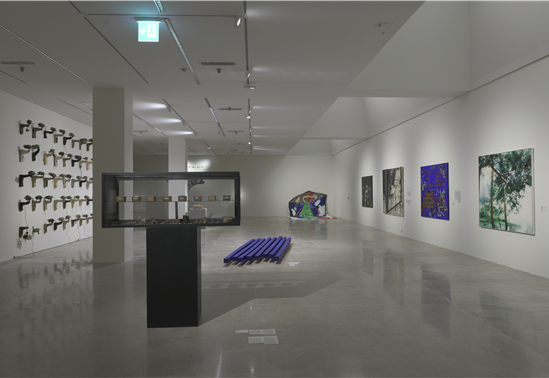
During the 1980s, Korean society underwent a period of upheavals. The hunger for democracy in the face of the repressions of the military administration led to a number of democratization movements, while the arrival of a late industrial society brought high– speed economic growth and rapid changes to daily life. Amid this social climate, the art world of the 1980s was divided into two strands: monochrome painting and the then–nascent movement of Minjung art. Artists graduating from art colleges in the early 1980s were forced to choose between these two paths. But those who sought to avoid being pulled into these major trends and to share their own voices without espousing particular ideologies would come together to form small groups, chiefly centered
around schools, where they were able to work freely.
This section looks at the activities of eight groups involved in notable activities during this time, including TA–RA, Contemporary Painting '82, Nanjido, META–VOX, Logos and Pathos, March in Seoul, Réalité Seoul, MUSEUM. Rejecting the uniform styles of past generations, they adopted a strategy of changing the inner structure of the Korean art world, focusing their efforts on new figurative paintings, free individual expression, and installation that emphasized material qualities. At times, the artists themselves would organize exhibitions without a curator, or band together to hold collaborative exhibitions.
But these small groups were merely cases of artists with a similar consciousness joining and working together around the same time; the groups were not oriented toward achieving any one clear goal. Also, since most of the small groups had the chief aim of achieving something "new" and breaking with established art practices, they did not remain active for long, lest they succumb to complacency and inertia. Along similar lines, members would not remain confined to one particular group, but circulate among different ones as they took part in exhibitions. These activities of small groups were significant as a form of practice by artists who sought to explore
their own direction of development for Korean art, rather than blindly adopting the Western art trends that were arriving in real–time on their shores.
Korean Art since the 1990s(11-15)
With Germany's reunification and the Soviet Union's dissolution in the early 1990s, Cold War ideologies and related discourses died down as concepts such as the environment and gender emerged as keywords to understanding the new world society. Globalization marked by increased mobility and advancements in information technology also accelerated developments in the communication systems including the internet. And as mass consumerism settled in, the line between high–end and popular cultures became blurred as decentralized and pluralistic cultural styles emerged. Since the 1990s to date, this pluralistic tendency has not only become a discourse of our time, but it has also served as a critical language in Korean art.
This exhibition examines this pluralistic tendency reflected in Korean contemporary artworks in five parts. "The Dawn of Globalization" portrays the age of increased mobility when Korean artists gained international stature and opened a Korea Pavilion at the Venice Biennale. "Conceptual Stance" captures the shift in artistic focus from the finished work to the process, circumstances, and concept behind art. "Critical Attitudes toward Reality" observes the perspectives from which artworks view social issues, the environment, urban development, and minorities. "Daily Life and Popular Culture" explores various images adopted by the mass media, while "Interdisciplinary Arts and the Broadening of Expression" looks at artworks and expressions that transcend the genres of art, dance, theatre, music, and film.
11. The Dawn of Globalization 1990s and Onward
As the Cold War era came to a close in the late 1980s, the world entered an era of pluralization. South Korea enjoyed a boost in prestige as it hosted large–scale international events like the 1988 Summer Olympics in Seoul and the 1993 Expo in Daejeon, while President Kim Young–sam named "globalization" as one of his administration's key governance tasks after taking office in 1993. As different globalization policies came together, international interchange began to proliferate in the field of art as well. Alongside efforts at mutual international exchange came attempts to share the latest Western discourses and art trends, and attention came to focus naturally on artists who were active beyond the national borders.
Representative examples of this include Nam June Paik, who was active in the international art world during the 1990s, and Kang Ikjoong and Bahc Yiso, who had migrated to the US. These artists drew attention for artworks reinterpreted Korean subject matter and traditional motifs. Designated as the "Year of Art," 1995 saw attempts to create an international network and boost the stature of Korean art with the creation of a Korea Pavilion at the Venice Biennale and establishment of the Gwangju Biennale. Matters such as "decentralization" and "pluralization" emerged as key issues at the biennales, and amid growing interest in non–Western artists, figures such as Kimsooja and Jheon Soocheon became actively involved in various international exhibitions, sharing the Korean or Oriental elements through massive installation and video works.
In this way, the early 1990s saw the Korean art world working to remove itself from the "non–Western" periphery of the international art scene amid the national policy efforts to achieve globalization and the corresponding social climate. But without the necessary criticism and institutional measures to process Western discourses and art trends into something of Korea's own, Korean art's globalization strategy focusing solely on quantitative expansion of overseas exchange led to one–off events or even reaffirmations of the boundaries and differences between countries.
12. Conceptual Stance 1990s and Onward
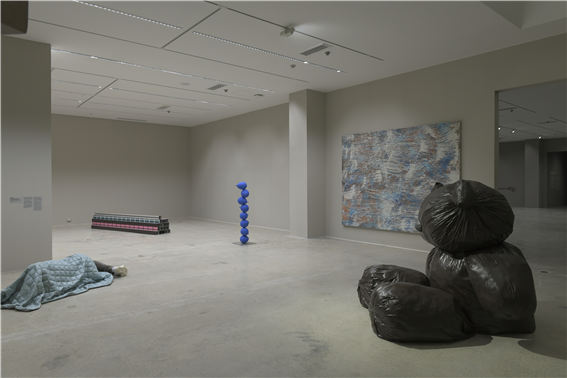
The 1990s could be described as the true emergence of Korean contemporary art as the ideological conflicts of past eras weakened and diversification and globalization began. With collectivism losing strength and society enjoying greater material abundance, the emergence of the individual and the growing interest in everyday life became important characteristics of the art of this period.
This section introduces a number of artists who were driving forces in this trend and whose work demonstrates a conceptual aspect. All of them are quite distinct, which makes them somewhat difficult to tie together, but they also show a number of common characteristics.
To begin with, their work has been seen as conceptual, or conceptualist, in the sense that its emphasis is less on the finished result than on the process, the situation, and the role of language
in establishing the artwork's concept. While the artists were interested in real–world issues, their
stance was personal yet metaphorical and indirect in a way that set them apart from the collectivist approach or the grand discourses of Minjung art. In formal terms, they distinguished themselves from the auteurism of modernist painting with their conscious suppression of aesthetic formativeness. The result was artwork that chiefly consisted of adopting ordinary objects and situations as subject matter and inverting the identities of objects; delving into the relationship between an object and the language that defines it; or revealing the hidden hierarchies of the relationship between action and object. With their encouragement of active contemplation on the viewer's part, these works had the aim of creating small cracks in our perspective on the everyday situations we take for granted, and on the act of art itself.
13. Critical Attitudes toward Reality Late 1990s
In the late 1990s, Korean society was undergoing rapid changes amid the direct influx of Western capitalist culture and the expansion of popular culture, and the focus shifted from the political issues discussed by Minjung art to matters of personal desire and identity. This was less a case of standardization toward a particular trend than of directing attention toward a wide range of issues from individual lives (including women, the environment, and sexuality), and art as well began taking on different forms.
Amid this environment, some artists developed an interest in art of a socially critical, praxis–oriented nature, exploring the relationship between art and public lives in the post–Minjung art era; indeed, the term "post–Minjung art" emerged amid perceptions that saw these trends sharing certain characteristics with Minjung art. But some have questioned whether the socially critical art of this era can actually be joined together under any particular current along the same lines as Minjung art. Whereas Minjung art stood for resistance and mass struggle as it focused on and represented political events, the art of this period exemplified a more self– reflective quality, its images of contemporary lives amid the consumption of popular culture revealing the ambivalent situations faced by those individuals.
14. Daily Life and Popular Culture 2000s and Onward
The 2000s would bring a large increase in artwork addressing daily life. Rather than focusing on specific incidents or individuals, artists found their subject matter in the repetition of day–to–day existence. To be sure, artwork that focused on daily life had existed in the past. But it was during this period that artists began distancing themselves from the superficial forms of modernism while refraining from direct expression of social and political issues in their work. In other words, they were shifting away from the conceptual and abstract and turning their attention to individual experience and the trivialities of ordinary existence. Artists also began observing the cities in which they were chiefly active. Where natural features such as mountains, fields, and rivers had been the subject of past artwork, the new subjects were the city's structures and roads, and the ordinary people living within them.
Meanwhile, the 2000s were also a period in which popular culture and consumer culture took hold. With the growth of the music market, the emergence of cable television, the development of the film industry, and the arrival of fashion trends since the mid–1990s, popular culture established itself as part of Korean society. The work of artists likewise transformed as a matter of course. Indeed, Koreans were encountering mass media every day in forms such as television, newspaper, film, and magazines. The various images appearing in mass media had already become part of everyday life, and artists began borrowing or combining from the flood of images to create new images.
15. Interdisciplinary Arts and the Broadening of Expression Mid–2000s and Onward
In the mid–2000s, "interdisciplinary arts" became the focus of growing activity in Korean art. In general terms, interdisciplinary arts refers to artwork that crosses boundaries of genres such as art, dance, theater, music, and film. While it certainly does focus on convergence and juxtaposition among genres, it does not simply refer to genre mixing. As each genre poses fundamental questions about genre perse, this gives rise to things that cannot be addressed through that genre alone, and a unique form of artwork emerged as a natural consequence of the sharing of those things.
The most important event for interdisciplinary arts at the time was Festival Bo:m. It was held every spring beginning in 2007 with participants from a wide range of areas, including artists, choreographers, theater and film professionals, and theorists. Many of the works were presented not in the gallery but in the theater or outdoors where viewers could observe the artistic process themselves.
Interdisciplinary arts was thus energized by the meeting of visual and performing arts, and artists would frequently come to collaborate with choreographers, dancers, and musicians. Sound and movement emerged as important elements in artwork, and works appeared in which the sounds and physical movements were important parts, even if they did not necessarily adopt a performance format.
